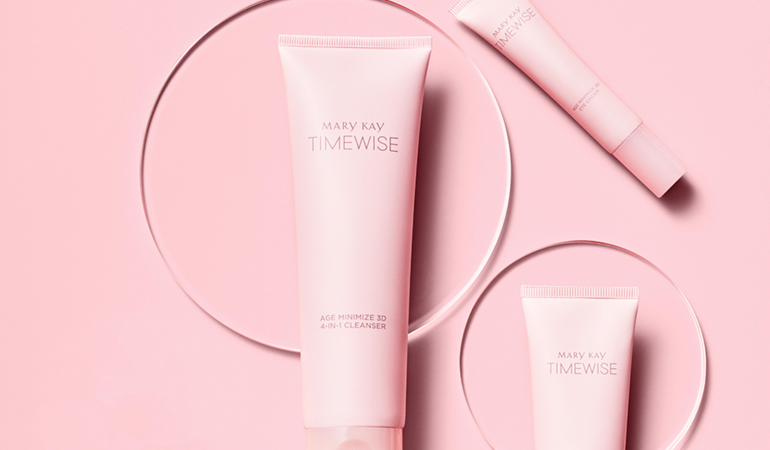MARY KAY PRODUCTS
Our Products
We strive to develop and maintain a hard-working core product portfolio with a strong value proposition that balances efficacy, quality, and price while delivering innovative new products that compel the customer to seek out a Mary Kay Beauty Consultant. Our product portfolio spans several significant categories including Skin Care, Body Care, Color Cosmetics, Fragrance, and Beauty Nutrition.

GLOBAL ACADEMY OF INNOVATION & SCIENCE
Led by Mary Kay Chief Scientific Officer Dr. Lucy Gildea, the Global Academy is dedicated to the research of skin and nutritional science through collaborations with industry-leading global institutions, dermatologists, researchers and scientific and academic authorities. Through its many initiatives, the Global Academy accelerates advancements in skin and nutritional research for the good of all. Science, safety and sustainability harmoniously intersect, proving that results don’t have to come with compromise. Supported by a team of in-house experts, you can trust in the verified technologies that inspire our innovative products.
SKIN HEALTH RESEARCH
Mary Kay Ash founded our company with the vision that a woman could achieve anything if she believes in herself and aligned that opportunity with selling skin care products. We recognize skin health as a critical need for overall well-being, as it not only impacts us physically in our daily lives, but also holistically. People want beauty that lasts forever and that it is our commitment to identify and design innovative line of skin care products, combined with academic research expert partnerships to deliver the best of the best to the end consumer. Mary Kay has invested in skin health research for nearly 60 years as part of our commitment to the safety and efficacy of our products as well as to the greater scientific community. As climate change and environmental stressors challenge skin health and wellness, Mary Kay will continue to lead education and research initiatives across the globe. Each year, our R&D team launches several beauty products supported by over 1600 patents.
Mary Kay has decades invested into advancing the research field of skin health. Mary Kays’ efforts include advancing skin research and investing in scientists and institutions to further skin research.
We have published research at conferences (abstracts and posters) and journal articles both from our internal research efforts as well as our collaborations with academic institutions.
We continue to research many pertinent skin topics
Our expertise in skin allows use to develop technology pertinent to our products
Skin aging is a complex biological process influenced by a combination of intrinsic factors (intrinsic aging), such as genetics and hormones and extrinsic factors (extrinsic aging), including UV exposure and pollution. Even though intrinsic and extrinsic skin aging are distinctive processes, they share similarities in molecular mechanisms. Reactive oxygen species (ROS), arising from oxidative cell metabolism, plays a major role in both processes. Elevated levels of ROS in extrinsic or intrinsic skin aging leads to the degradation of collagen, elastin, hyaluronic acid and other dermal matrix components while dampening the skin’s barrier function and the ability to regenerate which further exacerbates the inflammatory response. These changes will naturally occur later in life in the case of intrinsically aged skin; however, it will occur much earlier in the case of photodamage. Each person has some level of both intrinsic and extrinsically aged skin regardless of their lifestyle, which is why women of all ages must be concerned with proper skincare and treatments. At Mary Kay, our primary focus is to understand how extrinsic and intrinsic factors play influence overall skin health and to identify technologies to combat aging for women across the globe.
Pollution
Today’s urban lifestyles expose the body to all sorts of constant environmental stress that is difficult to avoid. With cigarette smoke, chemicals and pollutants, the skin of city dwellers is constantly under severe strain. Environmental stressors such as air pollution, ozone, heavy metals, particulate pollutants (PM 2.5), and cigarette smoke mediate negative effects on the skin through the generation of reactive oxygen species (ROS) or free radicals. Along with aging and UV radiation, these pollutants are a source of chronical inflammation which leads to damaged skin cells and premature skin aging.
Skin Barrier & Redness
Chronologically aged skin displays multiple functional changes both in the dermis and the epidermis. Epidermal dysfunction, compromised permeability homeostasis, reduced stratum corneum hydration and elevated skin surface pH have been shown to be associated with cutaneous aging. Improvements in epidermal function has been shown to be effective in the prevention and treatment of some aging-associated cutaneous disorders, including dermatitis, pruritus, xerosis and rosacea (Elias & Mauro 2020). The epidermal permeability barrier resides in the stratum corneum, the outermost layer of the epidermis. The stratum corneum is comprised of flattened cells (corneocytes) surrounded by a lipid matrix. This ‘brick and mortar’ like structure is tightly packed and held together by tight junction proteins that provide structural and mechanical integrity to the stratum corneum. According to the brick-and-mortar model, this permeability barrier is largely determined by quality and quantity of differentiation-related proteins and extracellular lipids in the stratum corneum. Moreover, levels of structural proteins for the epidermal permeability barrier, including filaggrin, loricrin and other late cornified envelope proteins, have been shown to decline in aged skin in comparison to young skin. Deficiencies in these proteins can result in a defective permeability barrier.